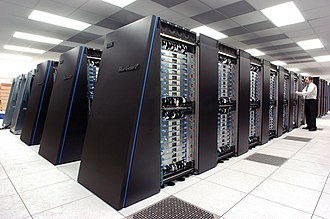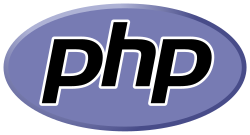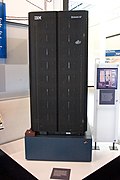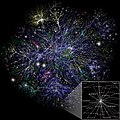Portal:Computer programming
Portal maintenance status: (September 2019)
|
The Computer Programming Portal
Computer programming or coding is the composition of sequences of instructions, called programs, that computers can follow to perform tasks. It involves designing and implementing algorithms, step-by-step specifications of procedures, by writing code in one or more programming languages. Programmers typically use high-level programming languages that are more easily intelligible to humans than machine code, which is directly executed by the central processing unit. Proficient programming usually requires expertise in several different subjects, including knowledge of the application domain, details of programming languages and generic code libraries, specialized algorithms, and formal logic.
Auxiliary tasks accompanying and related to programming include analyzing requirements, testing, debugging (investigating and fixing problems), implementation of build systems, and management of derived artifacts, such as programs' machine code. While these are sometimes considered programming, often the term software development is used for this larger overall process – with the terms programming, implementation, and coding reserved for the writing and editing of code per se. Sometimes software development is known as software engineering, especially when it employs formal methods or follows an engineering design process. (Full article...)
Selected articles - load new batch
-
Image 1

tcsh and sh shell windows on a Mac OS X Leopard desktop
A Unix shell is a shell that provides a command-line user interface for a Unix-like operating system. A Unix shell provides a command language that can be used either interactively or for writing a shell script. A user typically interacts with a Unix shell via a terminal emulator; however, direct access via serial hardware connections or Secure Shell are common for server systems. Although use of a Unix shell is popular with some users, others prefer to use a windowing system such as desktop Linux distribution or macOS instead of a command-line interface.
A user may have access to multiple Unix shells with one configured to run by default when the user logs in interactively. The default selection is typically stored in a user's profile; for example, in the local passwd file or in a distributed configuration system such as NIS or LDAP. A user may use other shells nested inside the default shell.
A Unix shell may provide many features including: variable definition and substitution, command substitution, filename wildcarding, stream piping, control flow structures (condition-testing and iteration), working directory context, and here document. (Full article...) -
Image 2

The source code for a computer program in C. The gray lines are comments that explain the program to humans. When compiled and run, it will give the output "Hello, world!".
A programming language is a system of notation for writing source code such as used to produce a computer program. A language allows a programmer to develop human readable content that can be consumed by a computer but only after translation via an automated process that enables source code to be executable. Historically, a compiler translates source code into machine code that is directly runnable by a computer, and an interpreter executes source code without converting to machine code. Today, hybrid technologies exist such as compiling to an intermediate form (such as bytecode) which is later interpreted or just-in-time compiled to machine code before running.
Computer architecture has strongly influenced the design of programming languages, with the most common type (imperative languages) developed to perform well on the popular von Neumann architecture. While early programming languages were closely tied to the hardware, modern languages hide hardware details via abstraction in an effort to enable better software with less effort. (Full article...) -
Image 3

Ruby is a general-purpose programming language. It was designed with an emphasis on programming productivity and simplicity. In Ruby, everything is an object, including primitive data types. It was developed in the mid-1990s by Yukihiro "Matz" Matsumoto in Japan.
Ruby is interpreted, high-level, and dynamically typed; its interpreter uses garbage collection and just-in-time compilation. It supports multiple programming paradigms, including procedural, object-oriented, and functional programming. According to the creator, Ruby was influenced by Perl, Smalltalk, Eiffel, Ada, BASIC, and Lisp. (Full article...) -
Image 4

Large supercomputers such as IBM's Blue Gene/P are designed to heavily exploit parallelism.
Parallel computing is a type of computation in which many calculations or processes are carried out simultaneously. Large problems can often be divided into smaller ones, which can then be solved at the same time. There are several different forms of parallel computing: bit-level, instruction-level, data, and task parallelism. Parallelism has long been employed in high-performance computing, but has gained broader interest due to the physical constraints preventing frequency scaling. As power consumption (and consequently heat generation) by computers has become a concern in recent years, parallel computing has become the dominant paradigm in computer architecture, mainly in the form of multi-core processors.
In computer science, parallelism and concurrency are two different things: a parallel program uses multiple CPU cores, each core performing a task independently. On the other hand, concurrency enables a program to deal with multiple tasks even on a single CPU core; the core switches between tasks (i.e. threads) without necessarily completing each one. A program can have both, neither or a combination of parallelism and concurrency characteristics.
Parallel computers can be roughly classified according to the level at which the hardware supports parallelism, with multi-core and multi-processor computers having multiple processing elements within a single machine, while clusters, MPPs, and grids use multiple computers to work on the same task. Specialized parallel computer architectures are sometimes used alongside traditional processors, for accelerating specific tasks. (Full article...) -
Image 5

Scala (/ˈskɑːlɑː/ SKAH-lah) is a strongly statically typed high-level general-purpose programming language that supports both object-oriented programming and functional programming. Designed to be concise, many of Scala's design decisions are intended to address criticisms of Java.
Scala source code can be compiled to Java bytecode and run on a Java virtual machine (JVM). Scala can also be transpiled to JavaScript to run in a browser, or compiled directly to a native executable. When running on the JVM, Scala provides language interoperability with Java so that libraries written in either language may be referenced directly in Scala or Java code. Like Java, Scala is object-oriented, and uses a syntax termed curly-brace which is similar to the language C. Since Scala 3, there is also an option to use the off-side rule (indenting) to structure blocks, and its use is advised. Martin Odersky has said that this turned out to be the most productive change introduced in Scala 3.
Unlike Java, Scala has many features of functional programming languages (like Scheme, Standard ML, and Haskell), including currying, immutability, lazy evaluation, and pattern matching. It also has an advanced type system supporting algebraic data types, covariance and contravariance, higher-order types (but not higher-rank types), anonymous types, operator overloading, optional parameters, named parameters, raw strings, and an experimental exception-only version of algebraic effects that can be seen as a more powerful version of Java's checked exceptions. (Full article...) -
Image 6

Perl is a high-level, general-purpose, interpreted, dynamic programming language. Though Perl is not officially an acronym, there are various backronyms in use, including "Practical Extraction and Reporting Language".
Perl was developed by Larry Wall in 1987 as a general-purpose Unix scripting language to make report processing easier. Since then, it has undergone many changes and revisions. Perl originally was not capitalized and the name was changed to being capitalized by the time Perl 4 was released. The latest release is Perl 5, first released in 1994. From 2000 to October 2019 a sixth version of Perl was in development; the sixth version's name was changed to Raku. Both languages continue to be developed independently by different development teams which liberally borrow ideas from each other.
Perl borrows features from other programming languages including C, sh, AWK, and sed. It provides text processing facilities without the arbitrary data-length limits of many contemporary Unix command line tools. Perl is a highly expressive programming language: source code for a given algorithm can be short and highly compressible. (Full article...) -
Image 7Mya was an intelligent personal assistant under development by Motorola. Proposed features for the program included the ability to read emails and answer questions 24 hours a day. Mya was intended to work with an internet service Motorola was developing called Myosphere, and was planned to be a paid service that would eventually be used by other mobile carriers. A female computer-generated character was created to represent Mya in advertising. While the quality of the character's animation was praised, it received criticism for being over sexualised.
Both the character and the program were announced to the public via an advertisement in March 2000, though the program was not ready for use at that time. Despite the announcement generating a considerable amount of attention, little was heard regarding the project in subsequent months. The program was never officially released nor cancelled, though the trademarks for both Myosphere and Mya were abandoned by Motorola in 2002. The name Mya was believed to be a play on the words 'My assistant'. (Full article...) -
Image 8

PHP is a general-purpose scripting language geared towards web development. It was originally created by Danish-Canadian programmer Rasmus Lerdorf in 1993 and released in 1995. The PHP reference implementation is now produced by the PHP Group. PHP was originally an abbreviation of Personal Home Page, but it now stands for the recursive backronym PHP: Hypertext Preprocessor.
PHP code is usually processed on a web server by a PHP interpreter implemented as a module, a daemon or a Common Gateway Interface (CGI) executable. On a web server, the result of the interpreted and executed PHP code—which may be any type of data, such as generated HTML or binary image data—would form the whole or part of an HTTP response. Various web template systems, web content management systems, and web frameworks exist that can be employed to orchestrate or facilitate the generation of that response. Additionally, PHP can be used for many programming tasks outside the web context, such as standalone graphical applications and drone control. PHP code can also be directly executed from the command line.
The standard PHP interpreter, powered by the Zend Engine, is free software released under the PHP License. PHP has been widely ported and can be deployed on most web servers on a variety of operating systems and platforms. (Full article...) -
Image 9Structured Query Language (SQL) (pronounced /ˌɛsˌkjuˈɛl/ S-Q-L; or alternatively as /ˈsiːkwəl/ ⓘ "sequel")
is a domain-specific language used to manage data, especially in a relational database management system (RDBMS). It is particularly useful in handling structured data, i.e., data incorporating relations among entities and variables.
Introduced in the 1970s, SQL offered two main advantages over older read–write APIs such as ISAM or VSAM. Firstly, it introduced the concept of accessing many records with one single command. Secondly, it eliminates the need to specify how to reach a record, i.e., with or without an index.
Originally based upon relational algebra and tuple relational calculus, SQL consists of many types of statements, which may be informally classed as sublanguages, commonly: data query language (DQL), data definition language (DDL), data control language (DCL), and data manipulation language (DML). (Full article...) -
Image 10In C++ computer programming, allocators are a component of the C++ Standard Library. The standard library provides several data structures, such as list and set, commonly referred to as containers. A common trait among these containers is their ability to change size during the execution of the program. To achieve this, some form of dynamic memory allocation is usually required. Allocators handle all the requests for allocation and deallocation of memory for a given container. The C++ Standard Library provides general-purpose allocators that are used by default; however, custom allocators may also be supplied by the programmer.
Allocators were invented by Alexander Stepanov as part of the Standard Template Library (STL). They were originally intended as a means to make the library more flexible and independent of the underlying memory model, allowing programmers to utilize custom pointer and reference types with the library. However, in the process of adopting STL into the C++ standard, the C++ standardization committee realized that a complete abstraction of the memory model would incur unacceptable performance penalties. To remedy this, the requirements of allocators were made more restrictive. As a result, the level of customization provided by allocators is more limited than was originally envisioned by Stepanov.
Nevertheless, there are many scenarios where customized allocators are desirable. Some of the most common reasons for writing custom allocators include improving performance of allocations by using memory pools, and encapsulating access to different types of memory, like shared memory or garbage-collected memory. In particular, programs with many frequent allocations of small amounts of memory may benefit greatly from specialized allocators, both in terms of running time and memory footprint. (Full article...) -
Image 11

Carphone Warehouse is a mobile phone retailer based in London, United Kingdom. In August 2014 the company became a subsidiary of Currys plc (previously named "Dixons Carphone"), which was formed by the merger of its former parent Carphone Warehouse Group with Dixons Retail. Prior to this merger, Carphone Warehouse Group was listed on the London Stock Exchange, and was a constituent of the FTSE 250 Index. Following the closure of all stand-alone UK stores in April 2020, all remaining Carphone Warehouse UK outlets were within branches of Currys PC World. In April 2021, the Carphone Warehouse business in Ireland (including all stand-alone and co-located branches and the website) was closed with immediate effect. Currys continued to use the Carphone Warehouse brand in the United Kingdom, online and, until 2021, inside Currys stores. (Full article...) -
Image 12

A computer lab contains a wide range of information technology elements,
including hardware, software and storage systems.
Information technology (IT) is a set of related fields within information and communications technology (ICT), that encompass computer systems, software, programming languages, data and information processing, and storage. Information technology is an application of computer science and computer engineering.
The term is commonly used as a synonym for computers and computer networks, but it also encompasses other information distribution technologies such as television and telephones. Several products or services within an economy are associated with information technology, including computer hardware, software, electronics, semiconductors, internet, telecom equipment, and e-commerce.
An information technology system (IT system) is generally an information system, a communications system, or, more specifically speaking, a computer system — including all hardware, software, and peripheral equipment — operated by a limited group of IT users, and an IT project usually refers to the commissioning and implementation of an IT system. IT systems play a vital role in facilitating efficient data management, enhancing communication networks, and supporting organizational processes across various industries. Successful IT projects require meticulous planning and ongoing maintenance to ensure optimal functionality and alignment with organizational objectives. (Full article...) -
Image 13
William Henry Gates III (born October 28, 1955) is an American businessman and philanthropist. A pioneer of the microcomputer revolution of the 1970s and 1980s, he co-founded the software company Microsoft in 1975 with his childhood friend Paul Allen. Following the company's 1986 initial public offering (IPO), Gates became a billionaire in 1987—then the youngest ever, at age 31. Forbes magazine ranked him as the world's wealthiest person for 18 out of 24 years between 1995 and 2017, including 13 years consecutively from 1995 to 2007. He became the first centibillionaire in 1999, when his net worth briefly surpassed $100 billion. According to Forbes, as of May 2025, his net worth stood at US$115.1 billion, making him the thirteenth-richest individual in the world.
Born and raised in Seattle, Washington, Gates was privately educated at Lakeside School, where he befriended Allen and developed his computing interests. In 1973, he enrolled at Harvard University, where he took classes including Math 55 and graduate level computer science courses, but he dropped out in 1975 to co-found and lead Microsoft. He served as its CEO for the next 25 years and also became president and chairman of the board when the company incorporated in 1981. Succeeded as CEO by Steve Ballmer in 2000, he transitioned to chief software architect, a position he held until 2008. He stepped down as chairman of the board in 2014 and became technology adviser to CEO Satya Nadella and other Microsoft leaders, a position he still holds. He resigned from the board in 2020.
Over time, Gates reduced his role at Microsoft to focus on his philanthropic work with the Bill & Melinda Gates Foundation, the world's largest private charitable organization, which he and his then-wife Melinda French Gates co-chaired from 2000 until 2024. Focusing on areas including health, education, and poverty alleviation, Gates became known for his efforts to eradicate transmissible diseases such as tuberculosis, malaria, and polio. After French Gates resigned as co-chair following the couple's divorce, the foundation was renamed the Gates Foundation, with Gates as its sole chair. (Full article...) -
Image 14
Augusta Ada King, Countess of Lovelace (née Byron; 10 December 1815 – 27 November 1852), also known as Ada Lovelace, was an English mathematician and writer chiefly known for her work on Charles Babbage's proposed mechanical general-purpose computer, the Analytical Engine. She was the first to recognise that the machine had applications beyond pure calculation.
Lovelace was the only legitimate child of poet Lord Byron and reformer Anne Isabella Milbanke. All her half-siblings, Lord Byron's other children, were born out of wedlock to other women. Lord Byron separated from his wife a month after Ada was born and left England forever. He died in Greece when she was eight. Lady Byron was anxious about her daughter's upbringing and promoted Lovelace's interest in mathematics and logic in an effort to prevent her from developing her father's perceived insanity. Despite this, Lovelace remained interested in her father, naming one son Byron and the other, for her father's middle name, Gordon. Upon her death, she was buried next to her father at her request. Although often ill in her childhood, Lovelace pursued her studies assiduously. She married William King in 1835. King was made Earl of Lovelace in 1838, Ada thereby becoming Countess of Lovelace.
Lovelace's educational and social exploits brought her into contact with scientists such as Andrew Crosse, Charles Babbage, Sir David Brewster, Charles Wheatstone and Michael Faraday, and the author Charles Dickens, contacts which she used to further her education. Lovelace described her approach as "poetical science" and herself as an "Analyst (& Metaphysician)". (Full article...) -
Image 15In computing, a compiler is a computer program that translates computer code written in one programming language (the source language) into another language (the target language). The name "compiler" is primarily used for programs that translate source code from a high-level programming language to a low-level programming language (e.g. assembly language, object code, or machine code) to create an executable program.
There are many different types of compilers which produce output in different useful forms. A cross-compiler produces code for a different CPU or operating system than the one on which the cross-compiler itself runs. A bootstrap compiler is often a temporary compiler, used for compiling a more permanent or better optimised compiler for a language.
Related software include decompilers, programs that translate from low-level languages to higher level ones; programs that translate between high-level languages, usually called source-to-source compilers or transpilers; language rewriters, usually programs that translate the form of expressions without a change of language; and compiler-compilers, compilers that produce compilers (or parts of them), often in a generic and reusable way so as to be able to produce many differing compilers. (Full article...)
Selected images
-
Image 1This image (when viewed in full size, 1000 pixels wide) contains 1 million pixels, each of a different color.
-
Image 2GNOME Shell, GNOME Clocks, Evince, gThumb and GNOME Files at version 3.30, in a dark theme
-
Image 3Ada Lovelace was an English mathematician and writer, chiefly known for her work on Charles Babbage's proposed mechanical general-purpose computer, the Analytical Engine. She was the first to recognize that the machine had applications beyond pure calculation, and to have published the first algorithm intended to be carried out by such a machine. As a result, she is often regarded as the first computer programmer.
-
Image 4A view of the GNU nano Text editor version 6.0
-
Image 5Deep Blue was a chess-playing expert system run on a unique purpose-built IBM supercomputer. It was the first computer to win a game, and the first to win a match, against a reigning world champion under regular time controls. Photo taken at the Computer History Museum.
-
Image 6Partial map of the Internet based on the January 15, 2005 data found on opte.org. Each line is drawn between two nodes, representing two IP addresses. The length of the lines are indicative of the delay between those two nodes. This graph represents less than 30% of the Class C networks reachable by the data collection program in early 2005.
-
Image 9An IBM Port-A-Punch punched card
-
Image 10A head crash on a modern hard disk drive
-
Image 12Output from a (linearised) shallow water equation model of water in a bathtub. The water experiences 5 splashes which generate surface gravity waves that propagate away from the splash locations and reflect off of the bathtub walls.
-
Image 13Grace Hopper at the UNIVAC keyboard, c. 1960. Grace Brewster Murray: American mathematician and rear admiral in the U.S. Navy who was a pioneer in developing computer technology, helping to devise UNIVAC I. the first commercial electronic computer, and naval applications for COBOL (common-business-oriented language).
-
Image 14A lone house. An image made using Blender 3D.
-
Image 15Stephen Wolfram is a British-American computer scientist, physicist, and businessman. He is known for his work in computer science, mathematics, and in theoretical physics.
-
Image 17Margaret Hamilton standing next to the navigation software that she and her MIT team produced for the Apollo Project.
-
Image 18Partial view of the Mandelbrot set. Step 1 of a zoom sequence: Gap between the "head" and the "body" also called the "seahorse valley".
Did you know? - load more entries

- ... that a "hacker" with blog posts written by ChatGPT was at the center of an online scavenger hunt promoting Avenged Sevenfold's album Life Is but a Dream...?
- ... that the 2024 psychological horror game Mouthwashing utilises non-diegetic scene transitions that mimic glitches and crashes?
- ... that the study of selection algorithms has been traced to an 1883 work of Lewis Carroll on how to award second place in single-elimination tournaments?
- ... that NATO was once targeted by a group of "gay furry hackers"?
- ... that a pink skin for Mercy in the video game Overwatch helped raise more than $12 million for breast cancer research?
- ... that the programming language Acorn System BASIC was so non-standard that one commenter suggested that using it on the BBC Micro would be a disaster?
Subcategories
WikiProjects
- There are many users interested in computer programming, join them.
Computer programming news
- 23 May 2025 –
- Authorities from Canada, Denmark, France, Germany, the Netherlands, the United Kingdom, and the U.S. announce a joint operation to crack down on malware around the world, which took down over 300 servers, neutralized 650 domains, and seized over €3.5 million (US$3.9 million) of cryptocurrency. (DW)
Topics
Related portals
Associated Wikimedia
The following Wikimedia Foundation sister projects provide more on this subject:
-
Commons
Free media repository -
Wikibooks
Free textbooks and manuals -
Wikidata
Free knowledge base -
Wikinews
Free-content news -
Wikiquote
Collection of quotations -
Wikisource
Free-content library -
Wikiversity
Free learning tools -
Wiktionary
Dictionary and thesaurus




















































